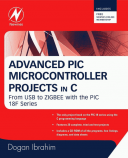Êíèãà: Advanced PIC Microcontroller Projects in C
Modifying the Program
Modifying the Program
In Figure 6.36 the display counts as 00 01…09 10 11…99 00 01… (i.e., the first digit is shown as 0 for numbers less than 10). The program could be modified so the first digit is blanked if the number to be displayed is less than 10. The modified program (called SEVEN5.C) is shown in Figure 6.37. Here, the first digit (MSD) is not enabled if the number to be displayed is 0.
/************************************************
Dual 7-SEGMENT DISPLAY COUNTER
==============================
In this project two common cathode 7-segment LED displays are
connected to PORTC of a PIC18F452 microcontroller and the
microcontroller is operated from a 4MHz resonator. Digit 1 (left
digit) enable pin is connected to port pin RB0 and digit 2
(right digit) enable pin is connected to port pin RB1 of the
microcontroller. The program counts up from 0 to 99 with one
second delay between each count.
The display is updated in a timer interrupt service routine at
every 5ms.
In this version of the program the first digit is blanked if the
number is 0.
Author: Dogan Ibrahim
Date: July 2007
File: SEVEN5.C
************************************************/
#define DIGIT1 PORTB.F0
#define DIGIT2 PORTB.F1
unsigned char Cnt = 0;
unsigned char Flag = 0;
//
// This function finds the bit pattern to be sent to the port to display a number
// on the 7-segment LED. The number is passed in the argument list of the function.
//
unsigned char Display(unsigned char no) {
unsigned char Pattern;
unsigned char SEGMENT[] = {0x3F,0x06,0x5B,0x4F,0x66,0x6D,
0x7D,0x07,0x7F,0x6F};
Pattern = SEGMENT[no]; // Pattern to return
return (Pattern);
}
//
// TMR0 timer interrupt service routine. The program jumps to the
// ISR at every 5ms.
//
void interrupt() {
unsigned char Msd, Lsd;
TMR0L = 100; // Re-load TMR0
INTCON = 0x20; // Set T0IE and clear T0IF
Flag = ~Flag; // Toggle Flag
if (Flag == 0) // Do digit 1
{
DIGIT2 = 0;
Msd = Cnt / 10; // MSD digit
if (Msd != 0) {
PORTC = Display(Msd); // Send to PORTC
DIGIT1 = 1; // Enable digit 1
}
} else { // Do digit 2
DIGIT1 = 0; // Disable digit 1
Lsd = Cnt % 10; // LSD digit
PORTC = Display(Lsd); // Send to PORTC
DIGIT2 = 1; // Enable digit 2
}
}
//
// Start of MAIN Program. configure PORTB and PORTC as outputs.
// In addition, configure TMR0 to interrupt at every 10ms
//
void main() {
TRISC = 0; // PORTC are outputs
TRISB = 0; // RB0, RB1 are outputs
DIGIT1 = 0; // Disable digit 1
DIGIT2 = 0; // Disable digit 2
//
// Configure TMR0 timer interrupt
//
T0CON = 0xC4; // Prescaler = 32
TMR0L = 100; // Load TMR0 with 100
INTCON = 0xA0; // Enable TMR0 interrupt
Delay_ms(1000);
for(;;) // Endless loop
{
Cnt++; // Increment Cnt
if (Cnt == 100) Cnt = 0; // Count between 0 and 99
Delay_ms(1000); // Wait 1 second
}
}

Figure 6.37: Modified program
- 10.2 Modifying the .emacs File Directly
- Modifying reservation properties
- 7.3.1 Modifying libraries to be thread-safe
- 4.4.4 The Dispatcher
- About the author
- Chapter 7. The state machine
- Appendix E. Other resources and links
- Example NAT machine in theory
- The final stage of our NAT machine
- Compiling the user-land applications
- The conntrack entries
- Untracked connections and the raw table




